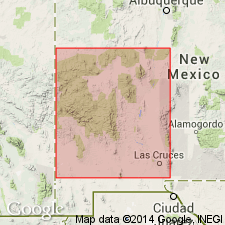
- Usage in publication:
-
- Magdalena Peak Rhyolite
- Modifications:
-
- First used
- Dominant lithology:
-
- Rhyolite
- AAPG geologic province:
-
- Orogrande basin
Summary:
First published use as a formation of the Santa Fe Group on west flank of Magdalena Range. [Described in earlier open-file reports; description therefore repeated here.] Type area located on and south of Magdalena Peak about 1.25 to 5 mi south of village of Magdalena on Magdalena Peak and along Hop and Agua Frio Canyons, sec 34, T2S, R4W and secs 2, 3, 10, 11, 14, 15, T3S, R4W, Socorro Co, NM, Orogrande basin. Consists of rhyolite domes and flows. Is pink, buff or gray and flow-banded rhyolite. Contains 10 to 20 percent phenocrysts of plagioclase, 2-3 percent biotite, 1 percent sanidine and traces of hornblende. Is 0-600 ft thick. Magdalena Peak is the only known vent area. Has an average 14.8 m.y. age from two K-Ar biotite dates. Lies above fanglomerates of Popotosa Formation. Top is erosional. Similar in age and petrographic character to Socorro Peak Rhyolite. Assigned a Miocene age.
Source: GNU records (USGS DDS-6; Denver GNULEX).
For more information, please contact Nancy Stamm, Geologic Names Committee Secretary.
Asterisk (*) indicates published by U.S. Geological Survey authors.
"No current usage" (†) implies that a name has been abandoned or has fallen into disuse. Former usage and, if known, replacement name given in parentheses ( ).
Slash (/) indicates name conflicts with nomenclatural guidelines (CSN, 1933; ACSN, 1961, 1970; NACSN, 1983, 2005, 2021). May be explained within brackets ([ ]).

